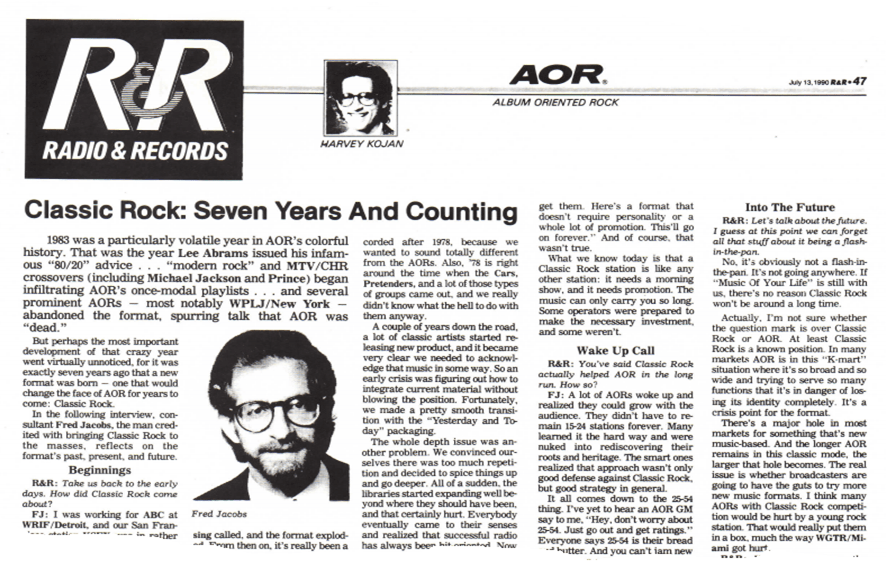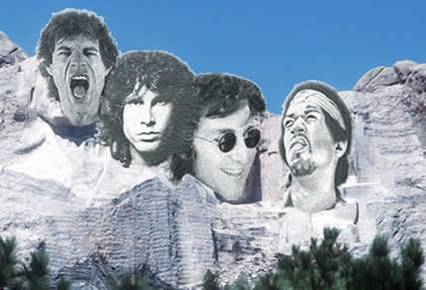It was 30 years ago this year that I was (finally) approached by an FM radio station that wanted to give the Classic Rock format a go. And three decades later, it hasn’t stopped yet. In fact, has even gained momentum in recent years.
When I left WRIF in ’83, Tom Bender and I had been noodling the idea of a format focused on just the greatest rock from the Beatles through the late ‘70s. He gave the concept a pretty nice run on the AM station he was running in Dallas – KRQX (the former WFAA). But after a couple years of contacting owner after owner in radio, I couldn’t find an FM station desperate enough to give the format a shot. And truth be told, I was losing faith.
Until I was approached by WMMQ’s Jeff Crowe and owner Bob Ottaway in early 1985. They were technically licensed to Charlotte (Chat-LOT) outside of Lansing, and were suffering as the fourth AC in the market. Bob was eager enough to try just about anything, and so we cut our deal at a restaurant right on the campus of Michigan State University.
We put Classic Rock on the station and it simply exploded. In just a few months, I was fortunate to sign on KCFX (Kansas City), KLSX (Los Angeles), WCXR (Washington, D.C.), WCSX (Detroit), and several others during a boom that continues to this day.
It is ironic that Mediabase dropped its Mainstream Rock chart last week, collapsing those stations into their Active Rock category. As it turned out, Classic Rock stations back in the ‘80s took on some of the biggest and best Mainstream Rock (or AOR) stations and did pretty well. Institutions like KMET, WMMS, KTXQ, WBCN, and many others shook and sometimes broke when attacked by the upstart Classic Rock format. And of course, there are many more Classic Rock stations in the U.S. than Mainstream, Active, Alternative, or Triple A stations.
Ironically, I also found myself consulting Mainstream Rock stations being attacked by someone else’s Classic Rock station. Figuring out how to defend the format wasn’t so easy, proving that what goes around…
We’ve built a website that has aggregated some memories of many of the people who were involved on the ownership and programming levels during those days. I learned a great deal from them along the way. You can check it out here, complete with lots of press clippings that talk a lot about the format (and show off some of my best and worst coiffures!). Thanks to Mike Stern and Seth Resler for putting it together.
It’s been fun and gratifying for me to watch this format morph, fragment, and mature over time. Today, it attracts younger listeners who now enjoy the music in a different way than their parents and grandparents did in real time back in the ‘60s, ‘70s, and ‘80s.
In retrospect, I learned a great deal about the power of nostalgia. The music you grew up with stays with you for your entire life whether it’s the Beatles, Frank Sinatra, U2, or Eminem.
We also got lucky. Classic Rock caught on as the rest of the pop culture world followed the hot new video trend blazed by MTV. As everyone else gravitated to Hair Bands, Michael Jackson, and Madonna, Classic Rock was like that old pair of jeans, featuring nothing but the best from evergreen artists like the Beatles, Stones, Zeppelin, and Pink Floyd.
And the development of the compact disc perfectly coincided with the rise of Classic Rock, encouraging fans to “upgrade” their old album collections with cool new digital versions of Sticky Fingers, Dark Side of the Moon, and Who’s Next.
Ironic, isn’t it, that now vinyl is making a major comeback.
I’d like to thank some of the earliest believers in the format (and me) who stuck with it during those formative years when our moves were more improvisational and gut-driven than strategic.
But now after having sat through hundreds of perceptual studies, and even more Classic Rock format and L.A.B. groups, I have a deeper understanding and respect for just how amazing this music is, and how important it is to the generations that love it.
Early on, I learned that inside the mind of just about every Classic Rock fan is a sort of Mt. Rushmore featuring the core bands that are most meaningful to each individual person. For some people, it’s a member of the Beatles or Jimmy Page. For others, it’s Eric Clapton, Hendrix, or Freddy Mercury. That’s the beauty of it because the format is deep, rich, and robust enough to satisfy many different tastes and experiences.
For a format that plays only catalogue, the ratings have held up better than anyone might have expected. But Classic Rock has edged near (and sometimes over) that dreaded “demographic cliff.” While younger listeners have joined the fold, the format continues to be challenged by the aging of the Baby Boomer audience.
I have faith in Classic Rock and the millions of fans who love and revere it. Thanks to everyone who’s made the journey with me over the years.
And they said it wouldn’t last.
Long live Classic Rock.
- What To Do If Your Radio Station Goes Through A Midlife Crisis - April 25, 2025
- A 2020 Lesson?It Could All Be Gone In A Flash - April 24, 2025
- How AI Can Give Radio Personalities More…PERSONALITY - April 23, 2025






Outstanding piece! The aggregated clippings and comments were very enjoyable reads. One thing I was able to take from a radio conference that I attended early in my career is the theory that just about everyone will have an emotional attachment to music that hit between the time a listener was 16 – 20 years old. (Heck, you might have even been the one who proposed it!). Applying it to the “demographic cliff” puts this audience into an age range of 50 – 71 years of age. Yet, the format is experiencing growth with younger demos. Parental influence and exposure, use in popular video games and the format expanding to include some better quality tracks from the 80’s may have helped growth with these audiences, but, like anything: Nothing really beats quality! To the audience, this is music from when the music mattered. This was a time when bands were signed to major label deals by music people instead of being based on their marketability by a “bean counter” or how “pretty” they could come across on the video.
The demographic cliff should be feared, lest the format fall by the wayside like the “Music Of Your Life” and 50’s/60’s oldies stations that have evolved to be “classic hits,” relegated to crappy low powered AM’s or disappeared altogether. Bill Sherard, in one of the aggregated stories (see link above) may have outlined what it will take to keep away the cliff; depth, creativity and emotion, a morning show with audience appeal, announcers who know and love the music, contests and community/audience involvement. As long as classic rock radio keeps “minding the store” based on these principals, it should be able to outlast another decade of “next big things.”
I like the way you’re thinking, Kurt. Clearly, it is essential that Classic Rock stations think, act, and sound like more than a nice collection of songs. I remember in the first couple of years that many people asked me whether a Classic Rock station should have a morning show – as if it somehow transcended the laws of great radio. The “secret sauce” of the format has always been what’s in between the songs, the station’s attitude, and the quality of personalities who (hopefully) exude the emotion they love the music as much as the audience does. Thanks for the kind words.
I may be a minor player in the consulting business, Fred, but there wouldn’t be anything for me to do if you hadn’t created Classic Rock three decades ago.
You built something that not only endured, it spawned some niche versions (one of which I exploit … heh heh heh) and when done properly, the format still gets great, saleable ratings.
Sir, I tip my hat — and anything else I can think of tipping, maybe a cow — to you.
K.M., thanks for the kind comments. And please don’t take it out on the cows. 🙂
Fred, you still owe me for all the CRAP I took from record companies for doing that R&R interview with you: “Kojan, WHAT ARE YOU DOING PROMOTING CLASSIC ROCK??!!”
Congrats!
Harvey
P.S. Which one of us is wearing the bigger glasses?
The question is, which one of us had more hair? I handpicked that article, and several people have told me how coincidental it was that it was on the same day as your new job announcement with Hearst. Thanks for always covering my follies, including Classic Rock!
Fred, this was great to read. Even today, I’m fascinated by the classic rock format. Think you could suggest more about how you see it evolving (without divulging secrets you’d rather sell)? I’m old. So, I prefer hearing the old classics, rotated right. I do prefer stations with a bit more depth than many classic rock stations, even if they do it more as spice, or “oh wow” songs to make me beg for another. Too many play such a narrow list, I feel burned by the repetition. Thanks for writing this and for creating the format in the first place. Oh, and Harvey, I loved reading that article way back then. Thanks!!
The playlist length conundrum has been a difficult balancing act from the beginning, Chris. Every station approaches it differently. Whether you have still competition, another station in your building playing rock, and a strong team of seasoned personalities are all part of the calculus that stations have to consider. Thanks for the kind comment.
Yeah. Even for our Triple A that leans on a classic rock catalog, the playlist length is a conundrum.
Does anyone believe in a connection between narrow playlists and the expanding use of services like Pandora? I am addressing the type of listener that might plug in up to 100 of their favorite songs and active or casually listen to a seemingly limitless library of songs based on the data surrounding the songs they input. To a classic rock listener, Sirius XM has their Deep Cuts channel as well as some classic rockers that have experimented with these sorts of stations on their HD channels. These have provided some outlet, but are listeners like that “niche” or are we underestimating their numbers?
As far as potentially losing a listener who “pushes the button” when an unfavorable song comes on: Has any research been done or based on experience, has positioning for this sort of thing ever worked? Something like setting up a station liner such as…”We here at “the Q” know that not everyone is going to love every song we play, but stick with us! We’ll bet you love the next one!” I know this a minor league example, but seriously, has positioning for a larger library ever worked?